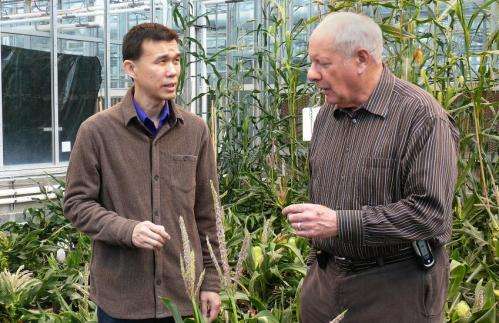Corn dwarfed by temperature dip suitable for growing in mines, caves

Lowering temperatures for two hours each day reduces the height of corn without affecting its seed yield, a Purdue study shows, a technique that could be used to grow crops in controlled-environment facilities in caves and former mines.
Raising the crops in isolated and enclosed environments would help prevent genetically modified pollen and seed from escaping into the ecosystem and crossing with wild plants.
Cary Mitchell, professor of horticulture, said the technique could be particularly useful for growing transgenic crops to produce high-value medicinal products such as antibodies for the budding plant-derived industrial and pharmaceutical compounds industry.
"Grains of corn could be engineered to produce proteins that could be extracted and processed into medicine, pharmaceuticals and nutraceuticals such as essential vitamins," he said. "This is a young industry, but what we've done is show that you can successfully grow these high-value crops in contained environments."
Mitchell described corn as a "good candidate crop" for the industry because of the plant's bounty of seeds and well-characterized genome, which can be modified in many ways. Using plants as "factories" to generate bioactive medicines would be far cheaper than the current methods that rely on cell cultures from mammals, he said.
But raising corn - a towering crop that needs bright light and heat - in a dark, cool, underground mine presented a challenge to Mitchell and then-postdoctoral researchers Yang Yang and Gioia Massa. They installed a growth chamber with insulation and yellow and blue high-intensity discharge lamps in a former limestone mine in Marengo, Indiana, to test how corn would react to an environment in which its growing conditions - light, temperature, humidity and carbon dioxide - were tightly controlled. To their surprise, the hybrid corn responded by growing "too well," said Yang.
"We coddled the plants with such luxurious conditions that the corn was touching the lamps before it had even tasseled," he said.
To reduce the corn's height, the researchers borrowed a trick used by the greenhouse industry to dwarf Christmas poinsettias. Using a growth chamber that mimicked the temperature conditions and carbon dioxide levels of the Marengo mine, they dropped the temperature to 60 degrees Fahrenheit for the first two hours of each photoperiod, the time in which the corn received light. The temperature was restored to 80 degrees for 14 hours and then lowered to 65 degrees for eight hours of darkness.
The temperature dip dwarfed stalk height by 9 to 10 percent and reduced stalk diameter by 8 to 9 percent without significantly affecting the number and weight of the seeds.
"This is a technique you could easily do in a mine or cave," Mitchell said. "It is an affordable, non-chemical means of taking genetically modified crops to harvest maturity without getting any kind of pollen or seed into the ecosystem."
He said that former mines could be prime locations to grow high-value, transgenic plants because their natural coolness lessens the need to ventilate the heat produced by lamps. The high levels of carbon dioxide in mines also promote plant growth.
"Productivity in a controlled environment is superior to that in the field, and you can raise more than one crop per year," Mitchell said. "Controlled environment agriculture is going to be one of the big movements of the 21st century."
More information: The study was published in Industrial Crops and Products and is available at www.sciencedirect.com/science/ … ii/S0926669013006791
Provided by Purdue University


















